Need a Video Resizer?
Try Movavi Video Converter!
- Lightning-fast conversion
- Batch processing of files – any number, any size
- No quality loss, even with 4K videos
- Easy editing and compression
How to resize your videos
Sometimes, you may need to resize your video or change its aspect ratio – for example, if you have a wide-screen (16:9 aspect ratio) HD video that you want to watch on the 4:3 aspect ratio screen of your iPod Classic. If you try to upload a video with an incorrect aspect ratio to your device, the video will either not play at all or will be displayed incorrectly (probably with stretched-out images).
You can correct the problem easily by resizing video with Movavi Video Converter. The program supports all popular video formats, including AVI, MOV, MP4, MPEG, and WMV, so you can use it to resize movies in almost any format as well as reduce video file size if necessary. Movavi Video Converter offers plenty of ready-made presets for popular websites and social networks, enabling you to resize video for YouTube, Facebook, and other sites.
To start working with Movavi’s video resizer app, download and install the Windows or Mac version of the software on your computer.
Using Movavi Video Converter, you can convert your video to any popular format and rescale it in just 5 easy steps:
Open Movavi Video Converter and add your video file to the program.
Select the desired output format for conversion.
Click the Cogwheel button next to the Output format field.
Specify the resolution of your video and choose the desired resize method.
Start conversion.
Let’s have a closer look at the fourth step. In Movavi Video Converter, you’ll find plenty of options for changing the resolution of your movie: you can use one of four automatic resizing presets, choose one of the standard video resolutions, or even set the width and height of your clip manually.
Automatic presets
All these four methods preserve the original frame proportions with no distortion in the output clip.
Smart fit
Let’s see how it works by resizing a 640 × 480 video, which aspect ratio is 4:3.
1. In the list of formats, select the preset with the desired resolution. For example, let’s select 1280 × 720 (an aspect ratio of 16:9). Then, in the Settings window, pick Smart fit in the Frame size list.
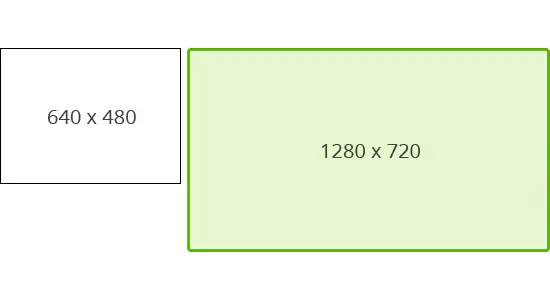
2. Now let’s imagine that we have two rectangles: the size of the first matches the width and height of the original video, and the dimensions of the second match the width and height of the chosen preset. The program overlays one rectangle with the other and changes the width and height of the 640 × 480 frame, placing it inside the second one.
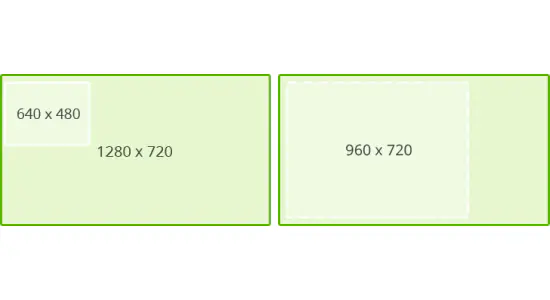
The size of the output video will be calculated as the size of the largest possible rectangle that fits inside the 1280 width and 720 height and retains the aspect ratio of the original video. In this case, the output size will be 960 × 720.
As you can see, the aspect ratio of the output video is still 4:3. When you play the resulting clip, you’ll find that the image looks exactly the same as the original, with no stretching or black bars around the clip.
Up to size
The size calculation is exactly the same as for the Smart fit tool, but, using this method, you can’t enlarge the original frame size. If you try to set a higher resolution, the resulting video will still have the same size as the original. “But how can it help me with processing video?” you may be asking yourself. Just imagine that you have a number of video clips, all with different resolutions, and you need to set a limit on their width and height during the conversion process. For example, imagine you are converting video for a mobile device with an 800 × 600 screen and you have three clips: 640 × 480, 800 × 600, and 1920 × 1080. If you manually set the 800 × 600 output resolution or use Smart fit, all three clips will be resized – the resolution of the first two clips will be enlarged, and for the third it will be reduced. However, for 640 × 480 and 800 × 600 videos, this kind of resizing is pointless for two reasons:
These clips can be correctly displayed on your device at their current size.
Increasing the video resolution during the conversion process simply adds unnecessarily to the size of the video without improving the quality.
So, in this case, you only need to downscale a video that is too big for your device resolution – and this is where Up to size can help you!
½ of original size and ¼ of original size
When you select these options, you are simply reducing the original width and height of your video by a factor of two or four.
Manual adjustment and standard resolutions
If you need to change the frame proportions in your video, you can easily set a new size manually. Select Custom from the Frame size list and enter the required values in pixels into the Width and Height fields. You can also pick one of the standard video resolutions from the same list.
Changing the proportions of an image can result in problems like unwanted stretching of the video, a pixelation effect, or unwanted black bars around the frame (the so-called “postage stamp effect”). To avoid these issues, set the correct resize method and resize quality parameters in the Settings window.
Resize methods
Now let’s review the available resize methods: Stretch, Letter box, Crop, and Auto (see the picture below).
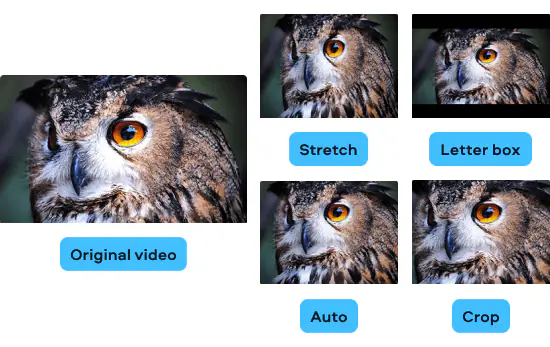
Stretch – the original video frame is stretched (or condensed) to the specified frame size (width and height).
Letter box – the original video frame is placed within the output frame. The aspect ratio stays the same, and the free space between the input and the output frames appears as black bars. This method is set by default in Movavi Video Converter.
Crop – the original video frame is placed within the output frame. The aspect ratio stays the same, and the parts of the input frame that go beyond the output frame size are cut off.
Auto – a compromise between Stretch and Crop. The program will simultaneously crop and stretch your video to meet the required size.
Resize quality
Four options are available for resize quality: Low (Draft), Good (Fast), High (Medium), and Best (Slow). The picture below shows the differences between the first and last of these options.
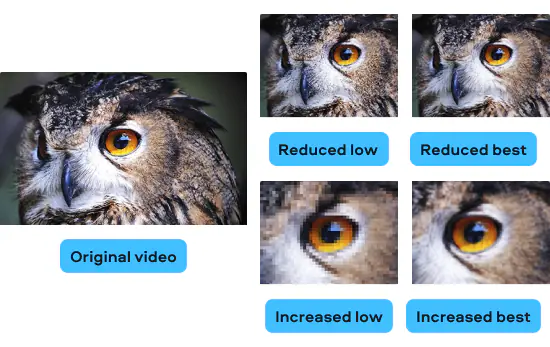
Low (Draft) – this mode uses the nearest-neighbor interpolation method. It works fairly quickly, but the quality of the output video is reflected in the speed. When you increase the frame size, there will likely be visible pixelation effects.
Good (Fast) and High (Medium) – both of these modes use bilinear interpolation. They work a little more slowly but provide a better video quality than the draft mode. The pixelation is still visible at larger frame sizes, but, in general, the image looks smoother. Good will work a bit faster than High and provide a somewhat lower image quality (as it is evident from their names), but in reality the difference is almost unnoticeable. You will likely only see a difference if you change the resolution considerably. The default mode in Movavi Video Converter is Good since it provides good balance between speed and quality.
Best (Slow) – uses bicubic interpolation. This process works much more slowly, but the quality of the output video is higher. When you increase the frame size, the image is smoothed and there is no pixelation. Additionally, when you reduce the frame size using this method, moiré patterns and other unwanted effects are much less likely to appear than for the other three methods, which can cause thin lines on your video to look broken and have an irregular thickness; Best quality will maintain the integrity of the thin lines.
Now you know about the resize types available in Movavi Video Converter and can choose the one that’s right for you. Resizing video is really easy – download the program now and try it yourself!
Movavi Video Converter
The ideal way to get your media in the format you need!
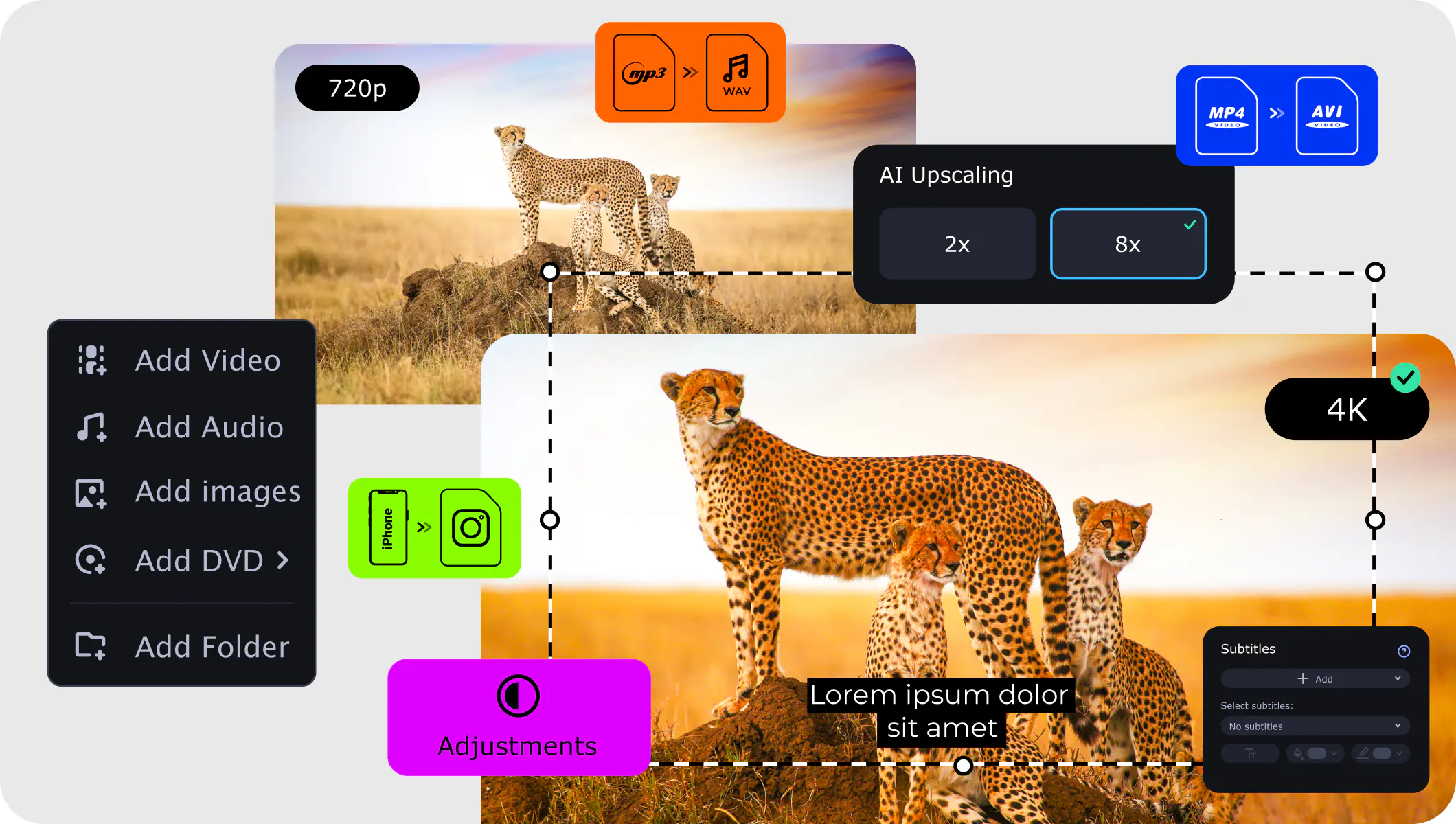
See other useful how-to guides

Have questions?
You may also like
An easy way to record from your screen in HD. Make video footage of any application, record online streaming video, webinars, even Skype calls, and save clips in all popular formats.
A comprehensive, streamlined video editing program that has everything you need to create amazing home movies with custom soundtracks, special effects, cool titles, and transitions.
Join for how-to guides, speсial offers, and app tips!
1.5М+ users already subscribed to our newsletter